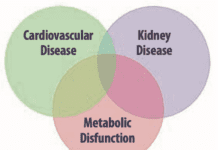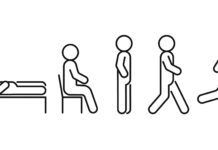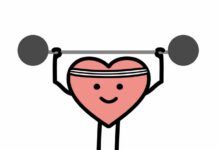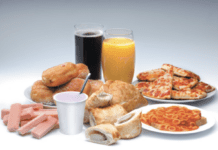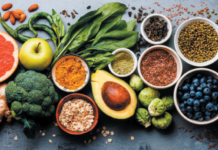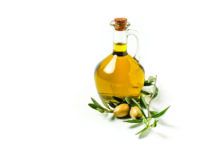You can never be too rich or too thin, the saying goes-and now a new study suggests the two conditions are connected. Adam Drewnowski, PhD, an epidemiologist at the University of Washington, recently found that people who shop at the priciest grocery stores-where its easier to find fresh and healthy foods-are dramatically thinner than shoppers at discount supermarkets.If people wanted a diet to be cheap, they went to one supermarket, Drewnowski says of the findings of the Seattle Obesity Study. If they wanted their diet to be healthy, they went to another supermarket and spent more.The results, he notes, underscore how much economics drives obesity and other effects of poor nutrition. People watching their wallets tend to buy foods that offer the most caloric bang for the buck: If you have two dollars and its dinner time, what will it be? A hamburger and fries-or two apples?But your diet doesnt have to be a prisoner of your pocketbook. If you become a nutrition-savvy supermarket shopper and are willing to sacrifice a little convenience, opting for raw ingredients instead of packaged and processed foods, you can be thinner and healthier even if youre not rich. In this Special Report, for example, we compare a days worth of eating according to the current federal Dietary Guidelines for Americans (see
| Breakfast Battle We priced a sample breakfast menu from the weeks worth of healthy menus at the USDAs MyPyramid website-adding a cup of coffee, black-and a comparable, convenience-oriented breakfast from the same supermarket. Heres how the two breakfasts stack up at the checkout: Healthy Breakfast 1 cup shredded-wheat cereal = 40 cents with 1 Tbsp raisins = 7 cents and 1 cup fat-free milk = 37 cents 1 small banana = 39 cents 1 slice whole-wheat toast = 21 cents with 1 tsp soft margarine = 3 cents and 1 tsp jelly = 4 cents 1 cup coffee = 10 cents Total = $1.62 Convenient Breakfast 1 supermarket bakery chocolate muffin = $1.75 1 7.7-ounce premade latte = $1.99 1 6.75-ounce citrus beverage = 44 cents Total = $4.18 |
And the winner is…? Healthy eating, which proved cheaper at every meal except snacktime and came in 43% cheaper for the whole days menu. The final tale of the supermarket tape, based on nationally available prices from the same source for both menus, was $9.20 per person for a days meals from the healthy-eating pyramid and $15.98 for the packaged and processed alternative menu.Although Drewnowski and other researchers on economics and nutrition emphasize the lower cost of lessnutritious calories, we didnt cheat and arrive at a cheaper total by significantly shorting calories. The average daily calorie count for the weeks worth of suggested menus at MyPyramid is 1,964, while our less-healthy comparison came in at 2,298. Much bigger differences show up in saturated fat (16 grams for the healthy menu vs. 35 grams) and sodium (1,948 milligrams vs. a whopping 3,615). The healthy menu actually delivers more protein (98 grams vs. 86) and dietary fiber (31 grams vs. 11), despite being $6.78 cheaper.
| Lunch Face-off For lunch, we compared a made-from-scratch turkey sandwich-priced based on buying a whole turkey breast, which obviously would last for several meals-versus a boxed supermarket sandwich, plus accompaniments: Healthy Lunch 3 ounces turkey breast = 67 cents on whole-wheat pita bread = 55 cents with 2 slices tomato = 47 cents and 1/4 cup Romaine lettuce = 4 cents and 1 Tbsp mayo-type salad dressing = 5 cents and 1 tsp yellow mustard = 5 cents 1/2 cup apple slices = 30 cents 1 cup low-sodium tomato juice = 64 cents Total = $2.77 Convenient Lunch 6-ounce Panini sandwich, smoked-turkey club = $3.99 1 12-ounce cola = 67 cents 1 candy bar = 99 cents Total = $5.65 |
No, the only trick is that the healthy days menu requires more preparation. (Depending on your family size, eating right economically may also demand more refrigerator and freezer storage. Our lunchtime turkey sandwich, for instance, cost only 67 cents for three ounces of turkey based on buying, roasting and slicing a whole turkey breast for multiple meals. Opting for pre-sliced deli turkey would cost $1.87 instead-still cheaper than a boxed sandwich.) To eat right cheaply, you have to rediscover the often-lost art of cooking mostly from scratch.Thats why Drewnowski urges public-health officials and supermarkets to sponsor cooking classes that would show how to create meals from ingredients that are nutritious, filling and cheap. He says, We have lost these skills and we need to bring them back.Convenience also comes with a cost, and its a growing factor in Americans food budgets and nutrition. Market research firm The NPD Group recently reported that about one in five US adults buys a prepared food from retail in a typical week, and predicted this trend would grow: We are a convenience-driven society.Driving for Dollars Recent efforts to improve the nations diet have focused on increasing the availability of healthy foods. A new government program, the Healthy Food Financing Initiative, will spend $400 million beginning next year to bring supermarkets to low-income areas and combat so-called food deserts where nutritious choices are tough to find.But Drewnowskis study raises questions about such efforts. His research team looked at 2,001 Seattle-area shoppers over four months, comparing their choice of supermarkets with their income, education and obesity as measured by Body Mass Index (BMI).Six out of seven people shopped for food outside their immediate neighborhood, he says. The closest supermarket for most people was less than a mile away, but people chose the market that was more than three miles away. Depending on their income, shoppers were willing to drive to save money as well as for quality and variety.Drewnowski cautions that his study was limited to Seattle, which does not have a food desert problem and where obesity, at about 20%, is much lower than the national average of 34%. Bringing grocery stores to neighborhoods that have none is a good idea, he adds. It does improve the economic vitality of neighborhoods and does improve quality of life. But lets not expect that everyone will then eat fresh fruit all day. Money still matters.
| Snack Showdown Only at snacktime did our healthy choices prove fractionally more expensive: Healthy Snack 1 cup plain low-fat yogurt (from tub) = 87 cents 2 Tbsp frozen berries = 34 cents Total = $1.21 Convenient Snack 1 100-calorie package cheese tortilla chips = 46 cents 1 12-ounce cola = 67 cents Total = $1.13 |
You Are Where You Shop
That economic impact was dramatic in Drewnowskis new study, which found that only about 4% of shoppers at pricey Whole Foods Market stores were obese (defined as a BMI of 30 or above). At the lower-priced Albertsons chain, by contrast, nearly 40% of customers were obese. Taken together, the areas three highest-priced stores- where a market basket of food totaled $370-$420-saw obesity rates among shoppers no higher than 12%. At the three cheapest groceries, where the same market basket cost $225-$280, obesity rates all topped 22%.Its not that the offerings at Whole Foods, Trader Joes and other pricier supermarkets are uniquely healthy. Rather, the wealthier and better-educated people who frequent those stores tend to have healthier lifestyles, prepare more-nutritious meals and dont have to worry about going hungry in-between paychecks.
| Dinner Duel We didnt cheat at dinnertime by skimping on food-the USDAs sample menu provides a substantial plateful. Nor did we tip the scales by adding a dessert to our comparison convenience meal-although many Americans would. But the healthy dinner still came in $1.42 cheaper: Healthy Dinner 5 ounces grilled top loin steak = $1.87 3/4 cup mashed potatoes, from scratch = 30 cents with 2 tsp soft margarine = 6 cents 1/2 cup steamed carrots = 14 cents with 1 Tbsp honey = 33 cents 2-ounce whole-wheat dinner roll = 50 cents with 1 tsp soft margarine = 3 cents 1 cup fat-free milk = 37 cents Total = $3.60 Convenient Dinner 1 9.6-ounce packaged Salisbury steak with macaroni and cheese = $3.69 2 slices packaged garlic bread = 96 cents 1 cup whole milk = 37 cents Total = $5.02 |
If youre on a fixed income or simply watching your food budget in trying economic times, the equation can seem daunting: For most people, eating right can easily cost more. But an investment in educating yourself about nutrition plus a little extra time in food preparation can pay big dividends, as our little exercise demonstrates.You dont have to be rich to be thin and healthy-just smart.TO LEARN MORE: MyPyramid www.mypyramid. gov.
| The Bottom Line Obviously, these are merely examples and prices can vary widely by supermarket, geography and season. But the point is that it is possible to eat better for less, by cooking more from scratch and buying in bulk instead of paying for serving-size packaging. It also makes sense to stock up when healthy items go on sale, of course. And dont be leery of frozen produce, which is typically picked when fruits or vegetables are at their best and which loses almost no nutrients compared to fresh.Heres how our comparison of a whole days eating (per person) added up:Healthy days menu = $9.20 Convenient days menu = $15.98 Savings from healthier, smarter shopping = $6.78 So what are you getting for your extra almost $7? Convenience and time-saving, supposedly. But studies have shown it really doesnt take that much longer to prepare meals from scratch. Once youve roasted, sliced and refrigerated that turkey breast, pulling it out and assembling your own lunchtime sandwich takes only a minute or two. In the time it takes to heat up a frozen dinner, you could easily fire up a gas grill or heat a grill pan and cook a lean steak, skinless chicken breast or fish fillet.Other healthy choices take no extra time at all: fat-free instead of whole milk or a soda, a piece of fruit rather than a candy bar, whole-grain bread in place of white bread made from flour thats had its natural goodness processed away.Other healthy choices take no extra time at all: fat-free instead of whole milk or a soda, a piece of fruit rather than a candy bar, whole-grain bread in place of white bread made from flour thats had its natural goodness processed away.What youre really getting for your money when you buy processed, packaged foods, it turns out, is saturated fat and sodium, which are linked to heart disease and high blood pressure. Our convenient days menu also totaled almost 200 grams of sugars-and recent research suggests that added sugars likewise play a role in heart disease. |



